
The Uffizi Gallery is a prominent art museum located adjacent to the Piazza della Signoria in the Historic Centre of Florence in the region of Tuscany, Italy. One of the most important Italian museums and the most visited, it is also one of the largest and best-known in the world and holds a collection of priceless works, particularly from the period of the Italian Renaissance.

Alessandro di Mariano di Vanni Filipepi, better known as Sandro Botticelli or simply Botticelli, was an Italian painter of the Early Renaissance. Botticelli's posthumous reputation suffered until the late 19th century, when he was rediscovered by the Pre-Raphaelites who stimulated a reappraisal of his work. Since then, his paintings have been seen to represent the linear grace of late Italian Gothic and some Early Renaissance painting, even though they date from the latter half of the Italian Renaissance period.

Filippino Lippi was an Italian painter working in Florence, Italy during the later years of the Early Renaissance and first few years of the High Renaissance.

Filippo Lippi, also known as Lippo Lippi, was an Italian painter of the Quattrocento and a Carmelite priest. He was an early Renaissance master of a painting workshop, who taught many painters. Sandro Botticelli and Francesco di Pesello were among his most distinguished pupils. His son, Filippino Lippi, also studied under him and assisted in some late works.

The Städel, officially the Städelsches Kunstinstitut und Städtische Galerie, is an art museum in Frankfurt, with one of the most important collections in Germany. The Städel Museum owns 3,100 paintings, 660 sculptures, more than 4,600 photographs and more than 100,000 drawings and prints. It has around 7,000 m2 (75,000 sq ft) of display and a library of 115,000 books.
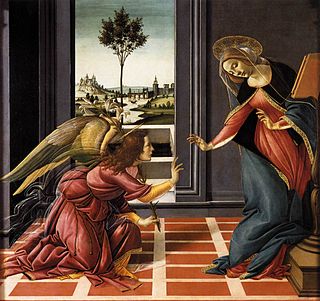
The Cestello Annunciation, is a painting in tempera on panel made in 1489 by Sandro Botticelli. It was painted for the patron Benedetto di Ser Giovanni Guardi to adorn the church of the Florentine monastery of Cestello, which is now known as Santa Maria Maddalena de'Pazzi.

The Madonna of the Book, or the Madonna del Libro, is a small painting by the Italian Renaissance artist Sandro Botticelli, and is preserved in the Poldi Pezzoli Museum in Milan. The painting is executed in tempera on panel. It dates from between 1480 and 1481.
Alain Jacquet was a French artist representative of the Nouvelle Figuration movement that was linked to the American Pop Art movement. Jacquet lived in New York and Paris and taught at the École Nationale Supérieure des Arts Décoratifs. He was married (1992) to Sophie Matisse, great-granddaughter of the French Fauvist artist Henri Matisse. They had one daughter, Gaïa Jacquet-Matisse. Jacquet's art is displayed in the Museum of Modern Art in New York, and the Centre Pompidou, the Musée National d'Art Moderne, in Paris. Jacquet died of esophageal cancer in Manhattan.
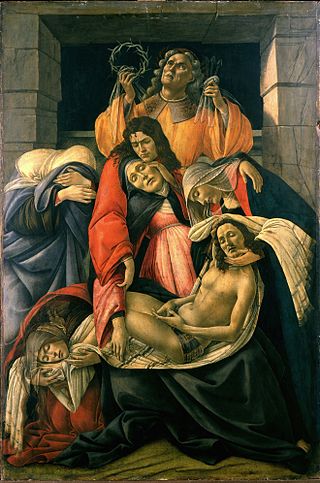
The Lamentation over the Dead Christ with Saints is a painting of the Lamentation of Christ by the Italian Renaissance artist Sandro Botticelli, dated between 1490 and 1495. The painting was originally kept in Santa Maria Maggiore, Florence. It is now in the Museo Poldi Pezzoli of Milan. The painting is one of two versions of The Lamentation by Botticelli. The other, circa 1492, is now in the Alte Pinakothek in Munich.

The Savoy Gallery is an art collection in the Italian city of Turin, which contains the royal art collections amassed by the House of Savoy over the centuries. It is located on Via XX Settembre, 86.

The Last Communion of Saint Jerome is a painting by the Italian Renaissance master Sandro Botticelli, finished around 1494–1495. It is now in the Metropolitan Museum of Art, in New York City.
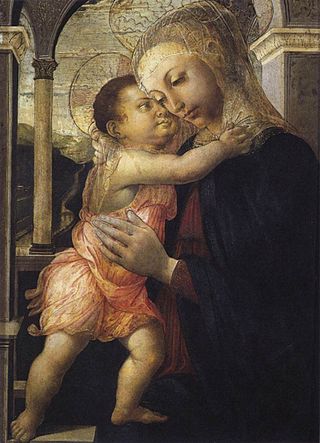
The Madonna della Loggia is a painting attributed to the Italian Renaissance artist Sandro Botticelli, dating to c. 1467. A tempera on panel work, it is located in the loggia of Uffizi, Florence, Italy.
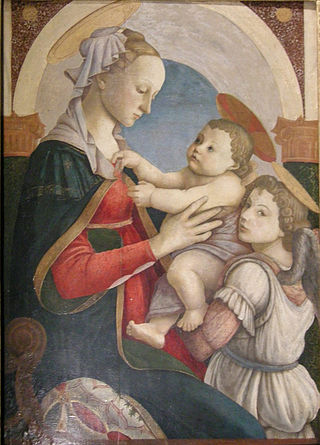
The Madonna and Child with an Angel is a painting by the Italian Renaissance painter Sandro Botticelli, c. 1465–1467. It is housed in Spedale degli Innocenti of Florence.

Portrait of a Young Woman is a painting which is commonly believed to be by the Italian Renaissance painter Sandro Botticelli, executed between 1480 and 1485. Others attribute authorship to Jacopo da Sellaio. The woman is shown in profile but with her bust turned in three-quarter view to reveal a cameo medallion she is wearing around her neck. The medallion in the painting is a copy in reverse of "Nero's Seal", a famous antique carnelian representing Apollo and Marsyas, which belonged to Lorenzo de' Medici.

Portrait of a Man is a c. 1478 painting by the Italian Renaissance painter Domenico Ghirlandaio (1449–1494) executed in tempera on wood.

Scenes from the Life of Saint Zenobius is a series of paintings by the Italian Renaissance artist Sandro Botticelli. Four panels from the series survive, which are now in three different museums. Each depicts three or more incidents from the life of Zenobius, an early Bishop of Florence who perhaps died in 417. The works are all in tempera on wood, and around 66 cm (26 in) high, though their length varies rather more, from about 149 to 182 cm.

The Annunciation is a small painting of the Annunciation by Sandro Botticelli. It is now in the collection of the Metropolitan Museum of Art in New York. The Metropolitan believe the work was painted as a single image for private devotional use, rather than as one of a set of predella scenes below the main panel of an altarpiece.
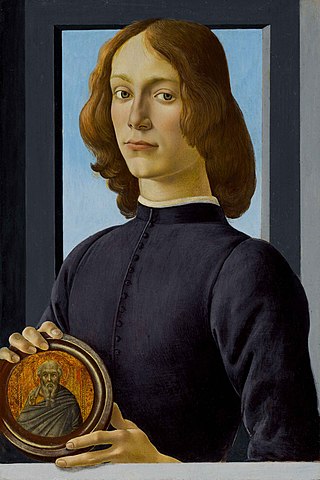
The Portrait of a Young Man Holding a Roundel is a painting attributed to Sandro Botticelli. Due to its style it has been estimated to have been painted around 1480. The identity of the portrait's subject is unknown, but analysts suggest it could be someone from the Medici family, as Lorenzo de' Medici was one of Botticelli's main benefactors.
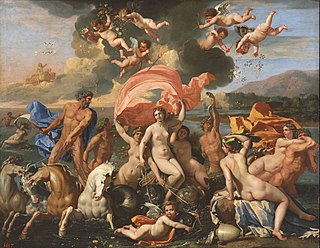
The Triumph of Neptune and Amphitrite by Nicolas Poussin, painted in 1635 or 1636, is a painting housed in Philadelphia in the Philadelphia Museum of Art. It is in oil on canvas and shows a group of figures in the sea near a beach, with putti flying over their heads.

The Man of Sorrows is a tempera and oil on panel painting of Jesus Christ by the Florentine artist Sandro Botticelli (1445-1510), thought to have been painted sometime between 1500 and 1510.




















